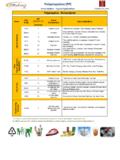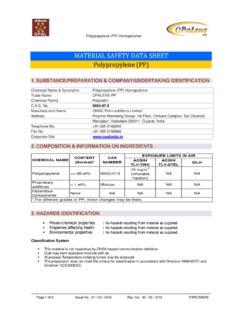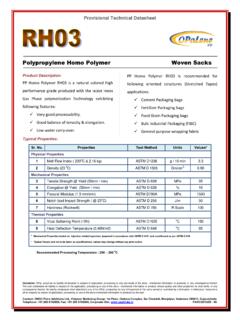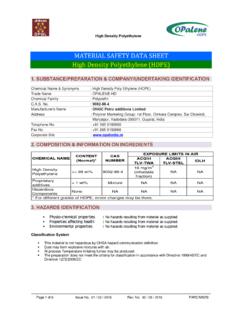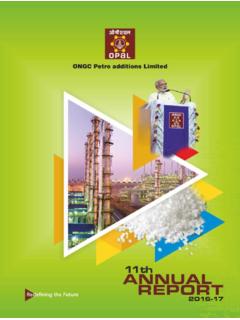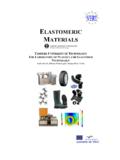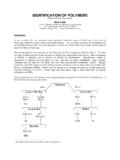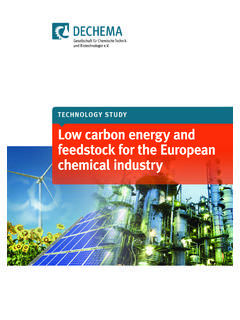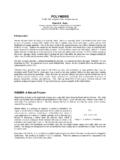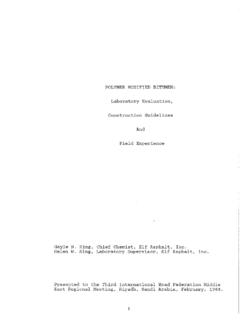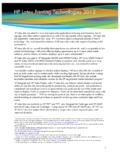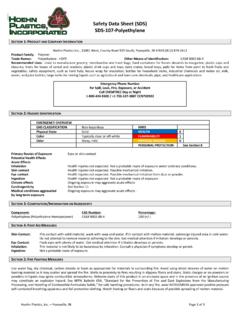Transcription of MATERIAL SAFETY DATA SHEET Polypropylene (PP)
1 Polypropylene (PP) Copolymer Page 1 of 6 Issue No. 01 / 03 / 2016 Rev. No. 00 / 03 / 2016 PARC/MSDS MATERIAL SAFETY data SHEET Polypropylene (PP) 1. SUBSTANCE/PREPARATION & COMPANY/UNDERTAKING IDENTIFICATION Chemical Name & Synonyms : Polypropylene (PP) Copolymer Trade Name : OPALENE-PP Chemical Family : Polyolefin No. : 9010-79-1 Manufacturer's Name : ONGC Petro additions Limited Address : Polymer Marketing Group: 1st Floor, Omkara Complex, Sai Chowkdi, Manjalpur, Vadodara-390011, Gujarat, India Telephone No. : +91 265 6192600 Fax No. : +91 265 6192666 Corporate Site : 2. COMPOSITION & INFORMATION ON INGREDIENTS ACGIHTLV-TWAACGIHTLV-STELIDLHP olypropylene Co-Polymer>= 99 wt%9010-79-110 mg/m3(inhalable fraction)NANAP roprietaryadditives< 1 wt%MixtureNANANAH azardous ComponentsNoneNANANANA* For different grades of PP, minor changes may be LIMITS IN AIRCHEMICAL NAMECONTENT (Normal)*CAS NUMBER 3.
2 HAZARDS IDENTIFICATION Physio-chemical properties : No hazards resulting from MATERIAL as supplied. Properties affecting health : No hazards resulting from MATERIAL as supplied. Environmental properties : No hazards resulting from MATERIAL as supplied. Classification System This MATERIAL is not hazardous by OHSA hazard communication definition. Dust may form explosive mixtures with air. At process Temperature irritating fumes may be produced. The preparation does not meet the criteria for classification in accordance with Directive 1999/45/EC and Directive 1272/2008/EC Polypropylene (PP) Copolymer Page 2 of 6 Issue No. 01 / 03 / 2016 Rev. No. 00 / 03 / 2016 PARC/MSDS 4. FIRST AID MEASURES GENERAL INFORMATION At room temperature the product is neither an irritant nor gives off hazardous vapours.
3 The measures listed below apply to critical situations (Fire, incorrect process conditions). Skin Contact If molten MATERIAL contacts the skin it may cause thermal burns, immediately flush with large amounts of cold water to cool the affected skin and polymer. Do not attempt to peel the polymer from skin. Obtain immediately emergency medical attention if burn is deep or extensive. Eye Contact Dust, fines and process vapours may irritate the eyes. Rinse immediately with plenty of water, also under the eyelids, for at least 15 minutes. Seek medical attention if discomfort persists. Inhalation Dust and process vapours may irritate the nose, throat and respiratory tract. If symptoms are experienced, move victim to fresh air. Obtain medical attention if breathing difficulty persists. Ingestion Adverse health effects due to ingestion are not anticipated.
4 Do not induce vomiting. If symptoms develop, obtain medical attention. 5. FIRE FIGHTING MEASURES Suitable Extinguishing Media As appropriate for surrounding fire. Extinguish preferably with foam, carbon Dioxide, water/water mist or dry chemical. Unsuitable Extinguishing Media Do not use high volume water jet or waterspray. Fire Fighting Protective Equipment A self-contained breathing apparatus and suitable protective clothing, eye protection etc should be used in fire conditions. Hazardous Decomposition Product Combustion or thermal decomposition will evolve toxic and irritant vapours. Unusual Fire & Explosion hazards Polymer dust particles in the atmosphere are combustible and may be explosive. CO, olefinic and paraffinic compound, trace amount of organicacids, ketones, aldehydes and alcohols may be formed during combustion. Other Can melt and burn in a fire.
5 Molten MATERIAL tends to flow or drip and will propagate fire. 6. ACCIDENTAL RELEASE MEASURES Personal Precautions : Avoid generating dust. Potential dust explosion hazard. Use only non-sparking tools. MATERIAL creates dangerous slipping hazard on hard surfaces. Ensure adequate ventilation, especially in confined areas. In case of insufficient ventilation wear suitable respiratory equipment. Environmental Precautions : Avoid release to environment. Do not allow to enter drains, sewers or watercourses Methods of cleaning up Take up mechanically and collect in suitable container for disposal. Good housekeeping must be maintained to avoid potential slipping problem. Keep walking surface free of spilled MATERIAL to avoid slipping hazard. Polypropylene (PP) Copolymer Page 3 of 6 Issue No.
6 01 / 03 / 2016 Rev. No. 00 / 03 / 2016 PARC/MSDS 7. HANDLING AND STORAGE Handling : No special requirements necessary, if handled at room temperature. Avoid spilling the product, as this might cause falls. Will accumulate static charges that may cause an electric spark (ignition source). Take precautionary measures against static discharges. Do not eat, drink or smoke at the work place. After handling, wash face and hands before eating, drinking or smoking. Storage : Requirements to be met by storerooms and containers: This product may react with strong oxidising agents & should not be stored near such materials. Store the bags in areas protected with automatic sprinklers. Storage temperature should be ambient. (preferably below 50 oC) Open flames prohibited.
7 Store the product in bags, car silos, container, or large cartons to avoid contamination. Further information about storage conditions: Protect from heat and direct sunlight. Store container in a well ventilated position. Store under dry conditions. Specific applications: For industrial use only, for safe stacking follow the storage recommendations specific for this product. 8. EXPOSURE CONTROLS / PERSONAL PROTECTION ENGINEERING CONTROLS: Use in a well-ventilated area. If handling results in dust generation, special ventilation may be needed to minimize dust exposure. If heated MATERIAL generates vapour or fumes, use process enclosures, local exhaust ventilation, or other engineering controls to control exposure. Occupational Exposure Limits: Substance CAS No. LTEL (8 hr TWA ppm) LTEL (8 hr TWA mg/m3 STEL (ppm) STEL (mg/m3) Remark Polypropylene Copolymer 9010-79-1 No Occupational Exposure limit assigned Inert or Nuisance Dust - 15 Total dust 5 Respirable dust * The USA-OSHA PEL for respirable dust is mg/m3 and mg/m3 for total dust.)
8 * The ACGIH Guideline for respirable dust is mg/m3 and mg/m3 for total dust. PERSONAL PROTECTIVE EQUIPMENT: Respiratory system Product processing, heat sealing of film or operations involving the use of wires or blades heated above 300 C may produce dust, vapour or fumes. To minimize risk of over exposure to dust, vapour or fumes it is Polypropylene (PP) Copolymer Page 4 of 6 Issue No. 01 / 03 / 2016 Rev. No. 00 / 03 / 2016 PARC/MSDS recommended that a local exhaust system is placed above the equipment, and that the working area is properly ventilated. If ventilation is inadequate, use certified respirator that will protect against dust/mist. Skin and body Hot MATERIAL : Wear heat-resistant protective gloves, clothing and face shield able to withstand the temperature of the molten product.
9 Cold MATERIAL : None required; however, use of gloves is good industrial practice. Hand Hot MATERIAL : Wear heat-resistant protective gloves able to withstand the temperature of the molten product. Cold MATERIAL : None required; however, use of gloves is good industrial practice. The correct choice of protective gloves depends upon the chemicals being handled, the conditions of work and use, and the condition of the gloves (even the best chemically resistant glove will break down after repeated chemical exposures). Most gloves provide only short time of protection before they must be discarded and replaced. Because specific work environments and MATERIAL handling practices vary, SAFETY procedures should be developed for each intended application. Gloves should therefore be chosen in consultation with the supplier/manufacturer and with a full assessment of the working conditions.
10 Eyes SAFETY glasses with side shields. Use dust goggles if high dust concentration is generated. Environmental Protection Emissions from ventilation or work process equipment should be checked to ensure they comply with the requirements of environmental protection legislation. In some cases, fume scrubbers, filters or engineering modifications to the process equipment will be necessary to reduce emissions to acceptable levels. 9. PHYSICAL AND CHEMICAL PROPERTIES FormSolid GranulesColourTranslucent to WhiteOdourOdourlessMelting point/Melting range130-170 CBoiling Point (oC)Not ApplicableFlash point> 300oCAutoignition temperature> 400 CDecomposition temperature> 300 CDanger of explosionProduct is not g/cm3pH (Value)Not ApplicableVapour Pressure (Pascal)Not ApplicablePercent Volatile by volume (%)< in / Miscibility with WaterInsolubleGeneral Information 10.
